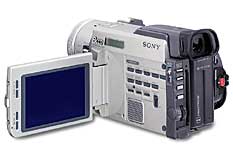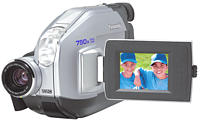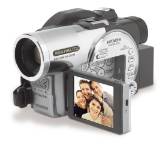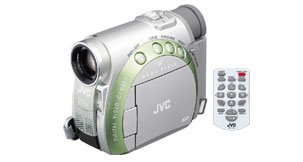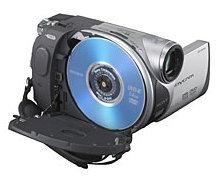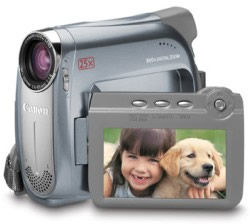| Home Glossary Formats How to choose |
| Sony |
| Hitachi |
| Panasonic |
| JVC |
| Canon |
| Samsung |
| Introduction | How to choose | Formats | Features |
| Media | Models |
|
Camcorders have only been around since 1983 when Sony introduced the
Betamovie camcorder. We've come a long way since then. Today there
are no less than six different tape formats plus DVD and Hard Disk
while the future may be high-capacity solid-state memory cards with no moving
parts. Today, Sony is still a leading camcorder maker along with Panasonic, JVC, Hitachi, Samsung, Toshiba, Sanyo and Canon. There are hundreds of camcorder models with new models coming out each year. Manufacturers introduce three or four new models every year sometimes even within each format category. Sony has four new DVD models and three new HDD models along with new HDV and MiniDV models in 2006. When new models appear, prices fall rapidly for the older models. The Sony 8mm tape camcorders are still popular despite their bulky size, with media being readily available for a low cost. For the lowest overall cost, a VHS-C or 8mm analog camcorder is still available. Most models however are going to be in a digital format. These include MiniDV, HDV, DVD and Hard Disk Drive models. The digital models are smaller and have much better image quality. See Camcorder Formats. Many camcorders use solid-state flash memory cards to store digital still photos or video clips. Models within the same format from the same manufacturer usually follow a trend of 2 or 3 models with the lower cost / less featured to the higher cost / more featured. The features which are offered with the higher cost model tends to involve either a bigger view screen, or higher resolution still images and a better lens. Panasonic offers a 3-CCD MiniDV model (most camcorders have only 1 CCD). The HDV or High-Definition camcorder will most likely be the next evolutionary step. Sony introduced in late 2004, a High-Definition MiniDV camcorder with 1080i resolution. Camcorders for 2005. |
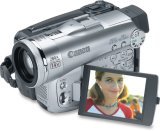 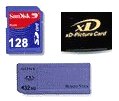  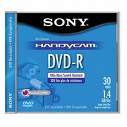 |
|||||||
| MiniDV tape DV (also referred to as MiniDV and DVC) camcorders make a high-quality digital video tape recording with a maximum duration of 80 minutes at SP (Standard-Play) speed. Tape contents can be transferred in real-time from camcorder to computer or to DVD recorder. Retail prices have generally come down for MiniDV models to under $400 for the average low to medium featured models. Recordable DVD DVD camcorders are becoming increasingly popular for the simple reason that it's easy to put the recorded disc into a DVD player and view our recordings. DVD camcorders use smaller (8cm) discs than the standard ones used normally, but all players can accept them. Retail prices for DVD models run about $400 to $800 with a few top end models around $1,000. HDD (Hard Disk Drive) Camcorders that use neither tape nor discs (like DV or DVD) save their video and also digital stills to high-capacity hard disks. Current models are JVC, with its Everio G range, and Sony, with its DCR-SR range. HDD camcorders use the same type of compressed recording system as DVD. JVC has a DVD disc-making station called the Everio Share Station which makes it easy to produce DVDs from selected files on the camcorder's internal HDD. Unless you plan to take your camcorder on a long trip far away from civilization and take hours and hours of video, you will not run out of disk space, however, if you want unlimited video recording capability, you'll need to use a tape or optical disc based camcorder simply because you can replace your media with blank cassettes or blank DVDs to the limit of what you can carry or afford to buy. Higher capacity hard drives may make this issue irrelevant. New HDD camcorders retail in the $600 range with a few top-of-the-line models just over $1,000. Solid State Camcorders These models have been around since 2003, from companies like Panasonic, Sanyo, Sony, use Flash Memory cards to save MPEG-2 and MPEG-4 video to a high-capacity card much like those that are used in your digital stills camera, only they can hold more information and can write/read data more quickly. Formats like Panasonic's SDR, or Sanyo's Xacti models, are gaining in popularity as the capacity of the cards increase to the equivalent of large DVD disks. HDV As this tape-based format becomes cheaper to acquire, we'll see an increase in its use. While HDV (High-Definition Video) is predominantly a tape-based format, camcorder makers are introducing high-definition recording systems which save clips to hard disk, DVD (HD versions) and SD media. We should see a significant shift towards solid-state HDV recording in the future. Which camcorder is best? The short answer is it depends on what you want to do with your video. If you're looking for a camcorder for general family or social context and whose clips are intended to be only edited very simply (or not at all), then DVD and HDD will be appropriate. With USB, you can move the video into a computer (often using software supplied for use with either Windows XP, Apple Mac or both) where editing can take place and any number of full-size DVDs can be produced. As far as DVD camcorders are concerned, you may wish to use write-once DVD-R discs and simply store them; however, re-writeable DVD-RW and DVD+RW discs are a better option since they can be re-used after your clips have been copied over to the computer. Camcorders that use HDD to save video clips have the potential to record up to 37 hours on a 30 Gigabyte hard disk drive at the lowest quality setting, but even the HQ setting can give you 7 hours recording. 60GB drives are also available now giving you even more recording time. As the disc onto which the clips are saved is fixed inside the camcorder, you'll need to copy off selected video prior to making DVDs of the content. If you want the best quality from a consumer format and also have a requirement to perform more accurate editing in a computer, then a MiniDV format camcorder (perhaps one that incorporates a flash media card like SD or Memory Stick PRO) will be your best choice for the immediate future. The DV recording stream still provides the best pictures and sound, and frame-accurate editing is easy. As for making DVD copies of your projects, the availability of suitable computer software is unrivaled in any other format. If you want top video quality for display on your HDTV, then you might choose an HDV camcorder which produces 1080 resolution as opposed to the 500 of DVD and MiniDV or the 250 of VHS. Conclusion For quick and easy video recording and playback with minimal editing, your choice is wide open. You may consider that a DVD camcorder provides the best value for money, given the availability of the discs. Running a close second, as MPEG-2 recording cameras go, is HDD; these models offer convenience and high storage capacity - but you need to copy the files off regularly. DV (MiniDV) is still the mainstay of consumer video. SD-Video format cameras will become more and more popular as the cost of the media comes down, and with companies like Panasonic incorporating SD-card slots into TV sets now, it's a practical way to view recordings quickly and easily. However, the cost of cameras and media remains high.
|
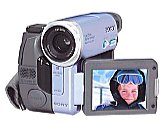 MiniDV 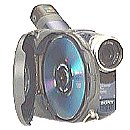 DVD 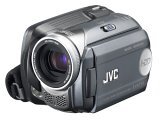 Hard Disk 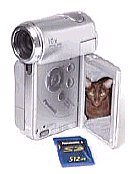 Solid state 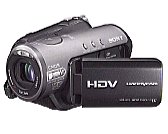 HDV |
